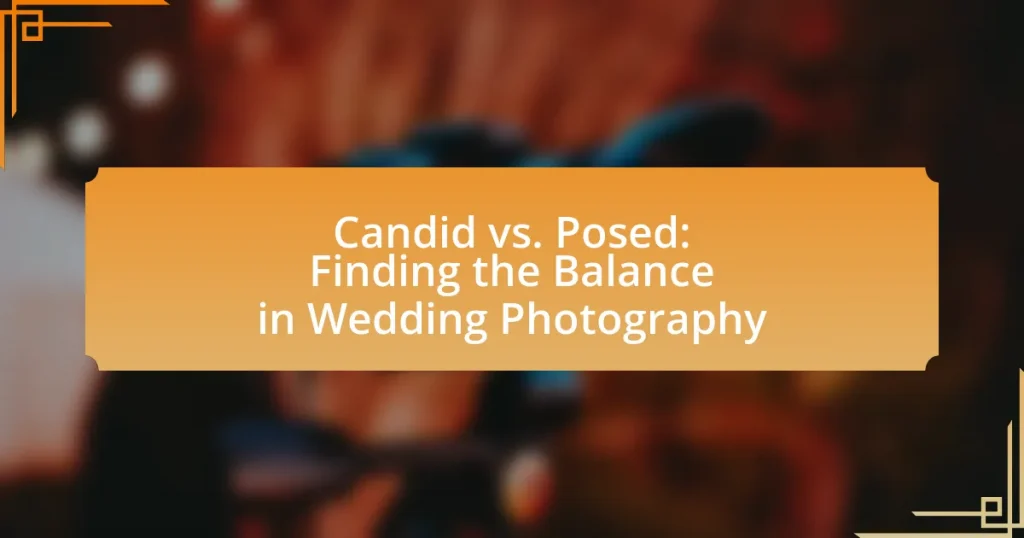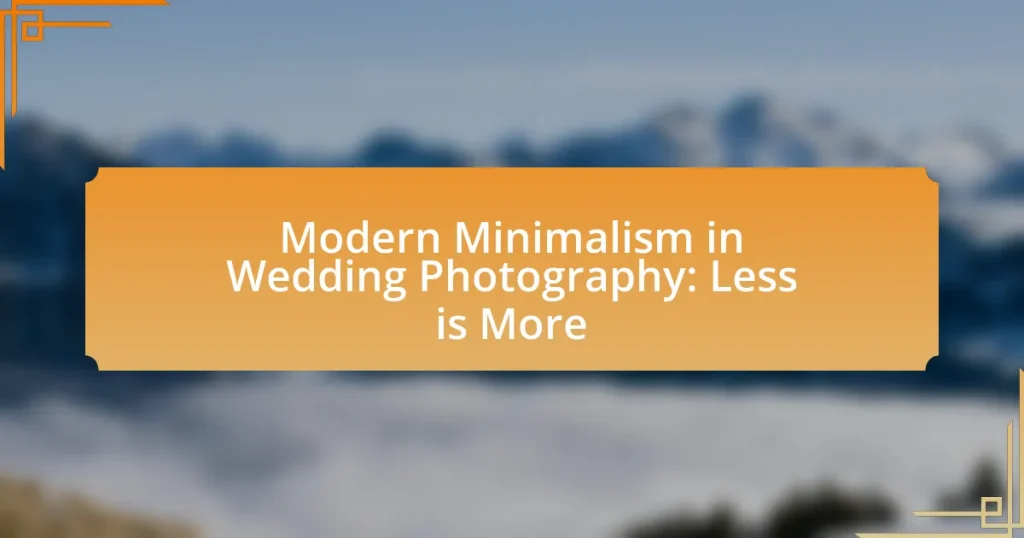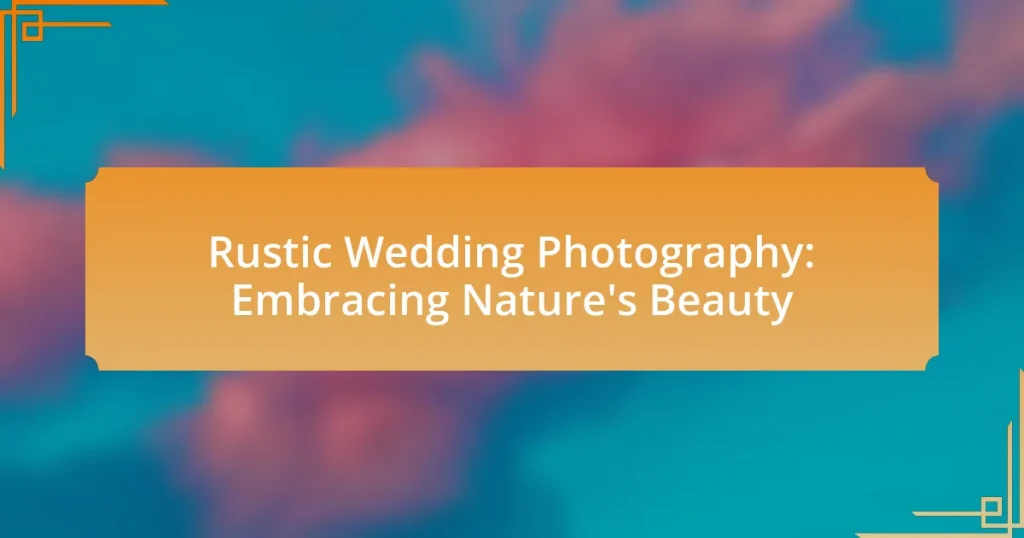The article “Candid vs. Posed: Finding the Balance in Wedding Photography” explores the distinctions between candid and posed wedding photography styles. Candid photography captures spontaneous moments and genuine emotions, while posed photography focuses on structured compositions and aesthetic appeal. The article discusses how both styles impact the overall wedding photography experience, emphasizing the importance of balancing authenticity with formal portraits. It also highlights the defining characteristics, advantages, and challenges of each style, along with practical tips for photographers to effectively combine both approaches to create a comprehensive visual narrative of the wedding day.
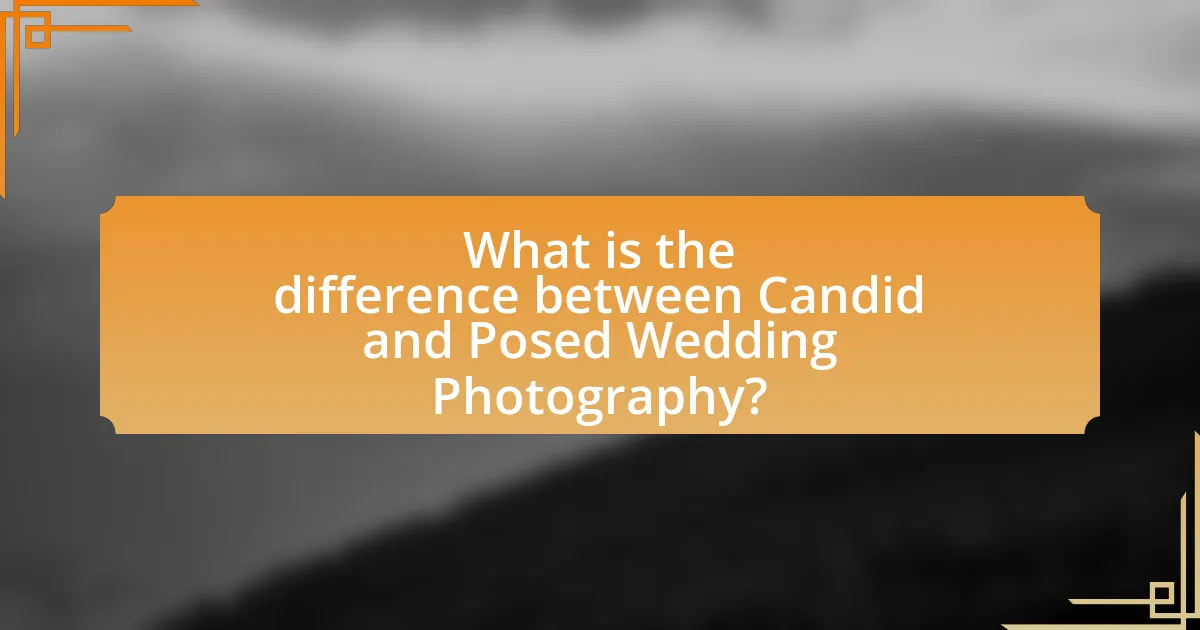
What is the difference between Candid and Posed Wedding Photography?
Candid wedding photography captures spontaneous moments without the subjects’ awareness, while posed wedding photography involves directing subjects into specific arrangements for the shot. Candid photography aims to document genuine emotions and interactions, often resulting in a more natural and storytelling approach, whereas posed photography focuses on creating aesthetically pleasing images through planned compositions. This distinction is evident in the final images, where candid shots reflect real-time events and emotions, while posed shots emphasize visual symmetry and intentionality.
How do Candid and Posed styles impact the overall wedding photography experience?
Candid and posed styles significantly impact the overall wedding photography experience by influencing the emotional tone and authenticity of the captured moments. Candid photography captures genuine emotions and spontaneous interactions, creating a narrative that reflects the true essence of the day, while posed photography allows for controlled compositions and ensures that key family and couple portraits are taken, providing a polished look. Research indicates that couples often prefer a mix of both styles, as it balances the authenticity of candid shots with the formality of posed images, resulting in a comprehensive visual story of their wedding day.
What are the defining characteristics of Candid photography?
Candid photography is characterized by its spontaneous and unposed nature, capturing genuine moments as they unfold. This style emphasizes natural expressions and emotions, often resulting in authentic storytelling through images. Unlike posed photography, which involves directing subjects, candid photography relies on the photographer’s ability to anticipate and seize fleeting moments, creating a sense of intimacy and realism. The use of natural light and unobtrusive techniques further enhances the authenticity of the captured scenes, making candid photography a preferred choice for documenting events like weddings, where genuine interactions are paramount.
What are the defining characteristics of Posed photography?
Posed photography is characterized by deliberate arrangement and positioning of subjects to create a specific composition. This style often involves careful consideration of lighting, background, and angles to achieve a desired aesthetic. In posed photography, subjects are typically instructed on how to stand, where to look, and how to interact, resulting in images that convey a sense of control and intention. The use of props and specific settings further enhances the visual narrative, making posed photography distinct from spontaneous or candid styles.
Why is it important to find a balance between Candid and Posed photography?
Finding a balance between candid and posed photography is crucial because it captures the essence of an event while also ensuring that key moments are documented. Candid photography provides authentic, spontaneous moments that reflect genuine emotions, while posed photography allows for controlled compositions that highlight important subjects and details. This balance ensures a comprehensive narrative of the event, appealing to both the emotional and aesthetic aspects of photography. Studies show that a mix of both styles leads to higher satisfaction among clients, as it preserves memories in a way that feels both real and artistically pleasing.
How does the balance affect the storytelling aspect of wedding photography?
The balance between candid and posed photography significantly enhances the storytelling aspect of wedding photography. This balance allows photographers to capture genuine emotions and spontaneous moments while also ensuring that key events and family portraits are documented. For instance, a study by the Wedding Photojournalist Association highlights that a mix of candid shots, which reflect real-time emotions, and posed images, which provide structure, creates a comprehensive narrative of the wedding day. This combination not only preserves the authenticity of the experience but also provides a cohesive story that resonates with viewers, making the memories more relatable and impactful.
What emotions do Candid and Posed shots evoke differently?
Candid shots evoke emotions of spontaneity and authenticity, while posed shots typically elicit feelings of formality and control. Candid photography captures genuine moments, often leading to a sense of joy and connection among subjects, as seen in studies showing that unplanned interactions foster stronger emotional responses. In contrast, posed shots, while aesthetically pleasing, can create a sense of distance or stiffness, as they often prioritize composition over natural expression. This distinction highlights how the context and execution of each style influence the emotional narrative conveyed in wedding photography.
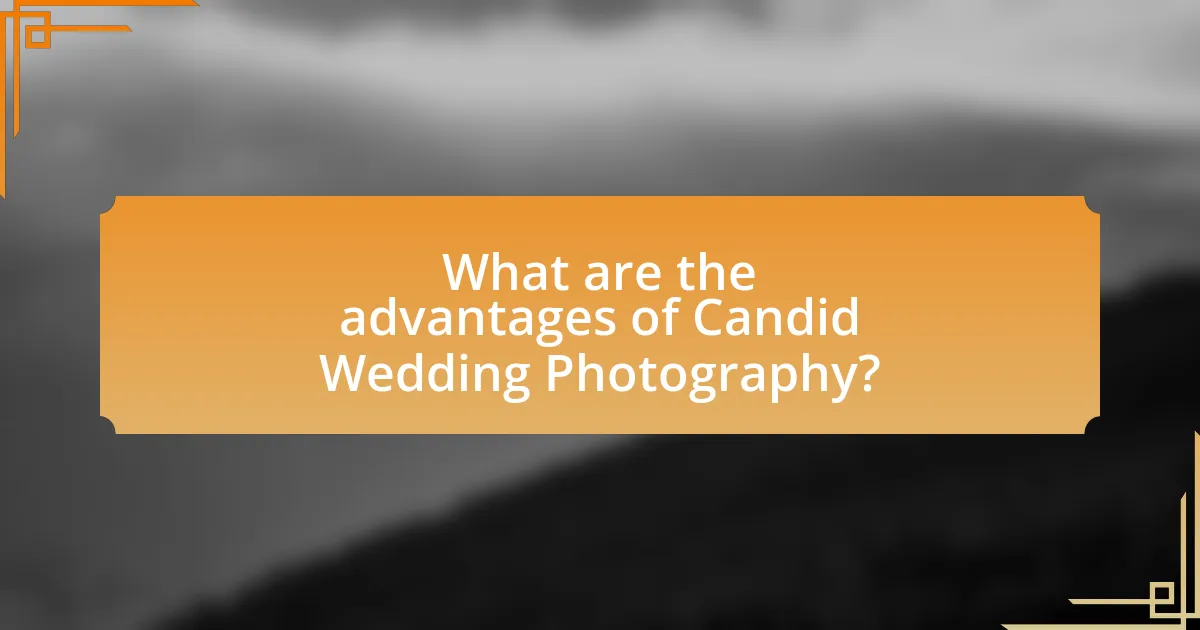
What are the advantages of Candid Wedding Photography?
Candid wedding photography offers the advantage of capturing genuine emotions and spontaneous moments, which reflect the true essence of the wedding day. This style allows photographers to document interactions and feelings without the constraints of posed setups, resulting in a more authentic narrative of the event. Studies show that couples often prefer candid images because they evoke real memories and emotions, enhancing the storytelling aspect of their wedding album. Additionally, candid photography can create a relaxed atmosphere, allowing guests to enjoy the celebration without the pressure of formal poses, leading to more natural and joyful expressions.
How does Candid photography capture genuine moments?
Candid photography captures genuine moments by focusing on spontaneous interactions and emotions without posing subjects. This approach allows photographers to document real-life events as they unfold, resulting in authentic expressions and unguarded reactions. Studies show that candid images often evoke stronger emotional responses from viewers, as they reflect true feelings and connections, rather than staged scenarios. For instance, a study published in the Journal of Visual Communication and Image Representation highlights that candid shots are perceived as more relatable and engaging compared to posed photographs, reinforcing the effectiveness of this style in capturing genuine moments.
What types of moments are best suited for Candid photography?
Candid photography is best suited for spontaneous moments that capture genuine emotions and interactions. These moments include laughter during speeches, tears of joy during vows, and playful interactions among guests. Such instances reflect the authenticity of the event, making them ideal for candid photography. Research indicates that candid shots often evoke stronger emotional responses from viewers, as they portray real-life scenarios rather than staged poses.
How does Candid photography reflect the couple’s personality?
Candid photography reflects the couple’s personality by capturing genuine emotions and spontaneous moments that reveal their unique interactions and characteristics. This style of photography emphasizes authenticity, showcasing the couple’s natural behaviors, laughter, and intimate exchanges, which often highlight their individual traits and shared dynamics. For instance, a couple that is playful and adventurous will likely be portrayed through candid shots of them laughing or engaging in fun activities, while a more reserved couple may be captured in quiet, tender moments. This approach allows viewers to connect with the couple on a personal level, as the images tell a story that is true to who they are, rather than a staged representation.
What challenges might arise with Candid photography?
Candid photography presents several challenges, including the difficulty of capturing spontaneous moments without disrupting the natural flow of events. Photographers often struggle with lighting conditions, as candid shots may occur in varying environments, requiring quick adjustments to settings. Additionally, subjects may not always be aware of the camera, leading to unflattering expressions or poses that do not convey the intended emotion. Furthermore, the unpredictability of candid moments can result in missed opportunities if the photographer is not prepared or positioned correctly. These challenges highlight the need for skillful anticipation and adaptability in candid photography.
How can photographers prepare for unpredictable moments in Candid photography?
Photographers can prepare for unpredictable moments in candid photography by maintaining a ready stance and being adaptable to changing situations. This involves using fast autofocus settings, keeping the camera at the ready, and being aware of the environment to anticipate spontaneous interactions. Studies show that photographers who practice situational awareness and quick reflexes capture more authentic moments, as they can react promptly to unexpected events. Additionally, familiarizing themselves with the event schedule and key moments can help photographers position themselves effectively to capture candid shots without intruding.
What techniques can enhance the quality of Candid shots?
To enhance the quality of candid shots, photographers should focus on techniques such as using natural light, capturing spontaneous moments, and employing a longer focal length. Natural light creates a soft and flattering effect, which is essential for candid photography. Capturing spontaneous moments allows for genuine emotions and interactions, making the images more relatable and impactful. Using a longer focal length helps to maintain distance from subjects, allowing for more authentic moments without intrusion. These techniques are supported by the fact that natural light is often preferred in photography for its ability to create depth and dimension, while candid shots are most effective when they reflect true emotions and interactions.
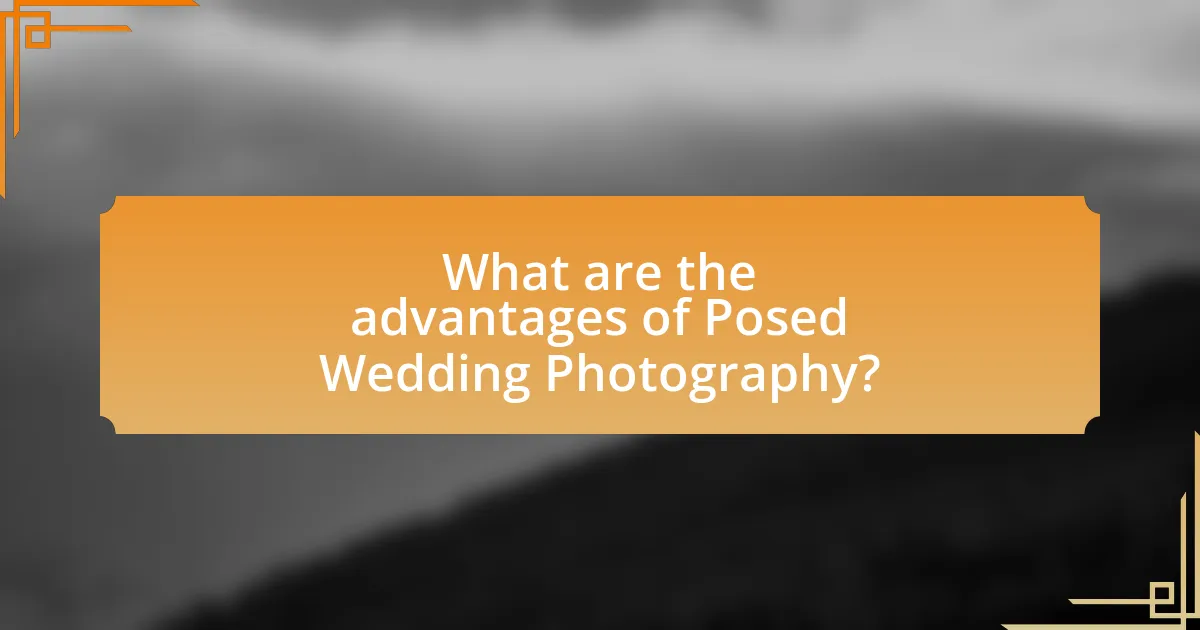
What are the advantages of Posed Wedding Photography?
Posed wedding photography offers several advantages, including the ability to create controlled and aesthetically pleasing images. This style allows photographers to carefully arrange subjects, ensuring optimal lighting, composition, and background, which can enhance the overall visual appeal of the photographs. Additionally, posed shots often result in timeless portraits that couples can cherish for years, as they capture the essence of the moment with clarity and intention. Furthermore, posed photography can help alleviate the stress of spontaneous moments, providing couples with a structured approach to their wedding day photography.
How does Posed photography ensure everyone looks their best?
Posed photography ensures everyone looks their best by allowing for careful composition, lighting, and direction. In posed settings, photographers can guide subjects into flattering angles and positions, which enhances their appearance. Additionally, controlled lighting can minimize shadows and highlight features, contributing to a polished look. Research indicates that well-posed photographs can significantly improve perceived attractiveness, as evidenced by studies showing that subjects in posed images are often rated higher in terms of visual appeal compared to candid shots.
What are the common poses used in wedding photography?
Common poses used in wedding photography include the classic portrait, the kiss, the first look, and the group shot. The classic portrait typically features the couple in a romantic embrace, highlighting their connection. The kiss pose captures the couple sharing a kiss, symbolizing their love and commitment. The first look pose showcases the couple’s emotional reaction when they see each other for the first time on their wedding day. The group shot involves family and friends gathered together, often arranged in a way that emphasizes the couple at the center. These poses are widely recognized in the industry for their ability to convey emotion and significance during the wedding ceremony.
How can Posed photography highlight important details of the wedding?
Posed photography can highlight important details of the wedding by intentionally framing subjects and elements to draw attention to specific moments and features. This technique allows photographers to capture the intricate details of the wedding attire, decorations, and emotional expressions in a controlled environment, ensuring that each element is showcased effectively. For instance, posed shots of the bride’s bouquet or the couple’s rings can emphasize their significance, while carefully arranged group portraits can reflect the relationships among family and friends. By utilizing lighting, composition, and timing, posed photography creates a narrative that enhances the visual storytelling of the wedding day.
What limitations does Posed photography have?
Posed photography has several limitations, primarily related to the authenticity and spontaneity of captured moments. This style often results in stiff or unnatural expressions, as subjects may feel uncomfortable or self-conscious during the shoot. Additionally, posed photography can miss genuine interactions and emotions that occur naturally, leading to a less dynamic representation of events. Studies in photography suggest that candid shots often evoke stronger emotional responses due to their authenticity, highlighting the contrast in emotional depth between posed and candid images.
How can overly posed shots detract from the authenticity of the wedding day?
Overly posed shots can detract from the authenticity of the wedding day by creating a sense of artificiality that does not reflect the genuine emotions and interactions of the event. When couples and guests are directed into stiff, unnatural positions, the resulting images often lack the spontaneity and warmth that characterize real moments. Research indicates that candid photography captures emotional expressions and interactions more effectively, leading to a more truthful representation of the day. For instance, a study published in the Journal of Visual Communication in Medicine highlights that candid images evoke stronger emotional responses from viewers compared to posed shots, reinforcing the idea that authenticity is compromised when the focus shifts to orchestrated poses.
What strategies can photographers use to make Posed shots feel more natural?
Photographers can make posed shots feel more natural by incorporating movement and interaction into the session. Encouraging subjects to engage with each other, such as holding hands or sharing a laugh, creates a relaxed atmosphere that translates into more genuine expressions. Additionally, using prompts that encourage spontaneity, like asking couples to walk towards the camera or share a private moment, helps to capture authentic emotions. Research indicates that natural interactions lead to more relatable and engaging photographs, as seen in studies on emotional expression in photography.
How can photographers effectively combine Candid and Posed styles?
Photographers can effectively combine Candid and Posed styles by strategically planning moments while remaining adaptable to spontaneous interactions. This approach allows photographers to set up posed shots that provide structure, while also capturing genuine emotions and interactions that occur naturally. For instance, during a wedding, a photographer can direct the couple for a posed portrait and then encourage them to engage in a candid moment, such as sharing a laugh or a private conversation. This technique not only creates a diverse portfolio but also reflects the authenticity of the event, as supported by studies showing that candid shots often evoke stronger emotional responses from viewers.
What is the ideal ratio of Candid to Posed shots for a wedding album?
The ideal ratio of candid to posed shots for a wedding album is typically 70% candid to 30% posed. This balance captures the spontaneity and emotional moments of the day while also including essential formal portraits. Research by wedding photographers indicates that couples prefer albums that reflect genuine interactions and emotions, which are best represented through candid photography.
How can communication with the couple help in blending both styles?
Effective communication with the couple facilitates the blending of candid and posed photography styles by ensuring that their preferences and expectations are clearly understood. When couples articulate their vision, photographers can tailor their approach to capture moments that resonate with the couple’s desired aesthetic. For instance, discussing specific moments they want to be candid versus those they prefer posed allows the photographer to strategically plan shots, ensuring a harmonious mix. Research indicates that clear communication enhances satisfaction in wedding photography, as couples feel more involved in the creative process, leading to a final product that reflects both styles effectively.
What practical tips can help achieve the right balance in wedding photography?
To achieve the right balance in wedding photography, photographers should blend candid and posed shots effectively. This can be accomplished by planning specific posed moments, such as family portraits, while remaining attentive to spontaneous interactions during the event. For instance, allocating time for formal group photos ensures that essential memories are captured, while also allowing for unobtrusive shooting during the ceremony and reception to document genuine emotions. Research indicates that a mix of both styles enhances storytelling in wedding albums, as it captures the essence of the day from multiple perspectives.
